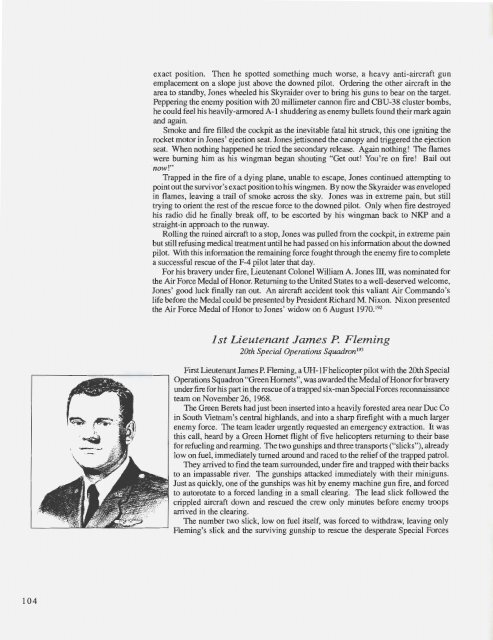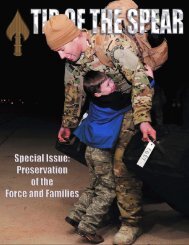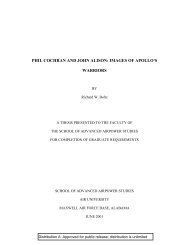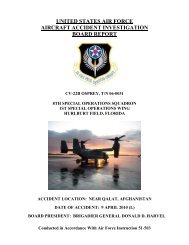Air Commando!: 1950-1975 - Twenty-five years at the Tip ... - AFSOC
Air Commando!: 1950-1975 - Twenty-five years at the Tip ... - AFSOC
Air Commando!: 1950-1975 - Twenty-five years at the Tip ... - AFSOC
Create successful ePaper yourself
Turn your PDF publications into a flip-book with our unique Google optimized e-Paper software.
exact posttton. Then he spotted something much worse, a heavy anti-aircraft gun<br />
emplacement on a slope just above <strong>the</strong> downed pilot. Ordering <strong>the</strong> o<strong>the</strong>r aircraft in <strong>the</strong><br />
area to standby, Jones wheeled his Skyraider over to bring his guns to bear on <strong>the</strong> target.<br />
Peppering <strong>the</strong> enemy position with 20 millimeter cannon fire and CBU-38 cluster bombs,<br />
he could feel his heavily-armored A-1 shuddering as enemy bullets found <strong>the</strong>ir mark again<br />
and again.<br />
Smoke and fire filled <strong>the</strong> cockpit as <strong>the</strong> inevitable f<strong>at</strong>al hit struck, this one igniting <strong>the</strong><br />
rocket motor in Jones' ejection se<strong>at</strong>. Jones jettisoned <strong>the</strong> canopy and triggered <strong>the</strong> ejection<br />
se<strong>at</strong>. When nothing happened he tried <strong>the</strong> secondary release. Again nothing! The flames<br />
were burning him as his wingman began shouting "Get out! You're on fire! Bail out<br />
.<br />
now.<br />
I"<br />
Trapped in <strong>the</strong> fire of a dying plane, unable to escape, Jones continued <strong>at</strong>tempting to<br />
point out <strong>the</strong> survivor's exact position to his wingmen. By now <strong>the</strong> Skyraider was enveloped<br />
in flames, leaving a trail of smoke across <strong>the</strong> sky. Jones was in extreme pain, but still<br />
trying to orient <strong>the</strong> rest of <strong>the</strong> rescue force to <strong>the</strong> downed pilot. Only when fire destroyed<br />
his radio did he finally break off, to be escorted by his wingman back to NKP and a<br />
straight-in approach to <strong>the</strong> runway.<br />
Rolling <strong>the</strong> ruined aircraft to a stop, Jones was pulled from <strong>the</strong> cockpit, in extreme pain<br />
but still refusing medical tre<strong>at</strong>ment until he had passed on his inform<strong>at</strong>ion about <strong>the</strong> downed<br />
pilot. With this inform<strong>at</strong>ion <strong>the</strong> remaining force fought through <strong>the</strong> enemy fire to complete<br />
a successful rescue of <strong>the</strong> F-4 pilot l<strong>at</strong>er th<strong>at</strong> day.<br />
For his bravery under fire, Lieutenant Colonel William A. Jones ill, was nomin<strong>at</strong>ed for<br />
<strong>the</strong> <strong>Air</strong> Force Medal of Honor. Returning to <strong>the</strong> United St<strong>at</strong>es to a well-deserved welcome,<br />
Jones' good luck finally ran out. An aircraft accident took this valiant <strong>Air</strong> <strong>Commando</strong>'s<br />
life before <strong>the</strong> Medal could be presented by President Richard M. Nixon. Nixon presented<br />
<strong>the</strong> <strong>Air</strong> Force Medal of Honor to Jones' widow on 6 August 1970. 192<br />
1st Lieutenant James P. Fleming<br />
20th Special Oper<strong>at</strong>ions Squadron 193<br />
First Lieutenant James P. Fleming, a UH-1 F helicopter pilot with <strong>the</strong> 20th Special<br />
Oper<strong>at</strong>ions Squadron "Green Hornets", was awarded <strong>the</strong> Medal of Honor for bravery<br />
under fire for his part in <strong>the</strong> rescue of a trapped six-man Special Forces reconnaissance<br />
team on November 26, 1968.<br />
The Green Berets had just been inserted into a heavily forested area near Due Co<br />
in South Vietnam's central highlands, and into a sharp firefight with a much larger<br />
enemy force. The team leader urgently requested an emergency extraction. It was<br />
this call, heard by a Green Hornet flight of <strong>five</strong> helicopters returning to <strong>the</strong>ir base<br />
for refueling and rearming. The two gunships and three transports ("slicks"), already<br />
low on fuel, immedi<strong>at</strong>ely turned around and raced to <strong>the</strong> relief of <strong>the</strong> trapped p<strong>at</strong>rol.<br />
They arrived to find <strong>the</strong> team surrounded, under fire and trapped with <strong>the</strong>ir backs<br />
to an impassable river. The gunships <strong>at</strong>tacked immedi<strong>at</strong>ely with <strong>the</strong>ir miniguns.<br />
Just as quickly, one of <strong>the</strong> gunships was hit by enemy machine gun fire, and forced<br />
to autorot<strong>at</strong>e to a forced landing in a small clearing. The lead slick followed <strong>the</strong><br />
crippled aircraft down and rescued <strong>the</strong> crew only minutes before enemy troops<br />
arrived in <strong>the</strong> clearing.<br />
The number two slick, low on fuel itself, was forced to withdraw, leaving only<br />
Fleming's slick and <strong>the</strong> surviving gunship to rescue <strong>the</strong> desper<strong>at</strong>e Special Forces<br />
104





